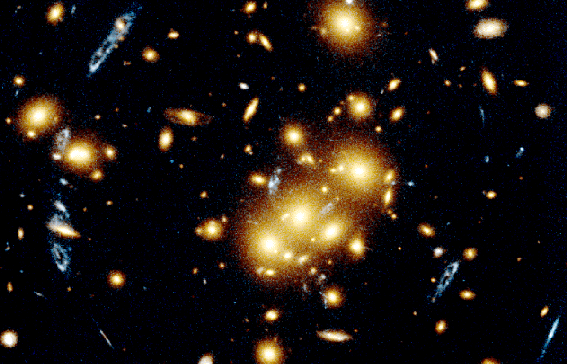Credit: W.N. Colley and
E. Turner
(Princeton University),
J.A. Tyson
(AT&T Bell Labs,
Lucent Technologies),
Hubble Space Telescope, and
NASA
Explanation:
What are those strange blue objects? Many are images of a single,
unusual, beaded, blue, ring-like
galaxy which just happens to line-up behind a giant
cluster of galaxies.
Cluster galaxies here appear yellow and --
together with the cluster's dark matter --
act as a
gravitational lens. A
gravitational lens can create several images of background galaxies,
analogous to the many points of light one would see while looking through a
wine glass at a distant street light.
The
distinctive shape of this
background galaxy -- which is probably just forming --
has allowed astronomers to deduce that it has separate
images at 4, 8, 9 and 10 o'clock, from the center of the cluster.
Possibly even the blue smudge just left of center is yet another image!
This
spectacular photo from
HST was taken in October 1994. The first
cluster lens
was found unexpectedly by Roger Lynds
(NOAO) and
Vahe Petrosian
(Stanford)
in 1986 while testing a new type of imaging device.
Lensed arcs around
this cluster, CL0024+1654, were first discovered from the ground by David
Koo (UCO Lick) in 1988.
Congratulations: Hubble Space Telescope is six years old today!
1999 2000 2001 2002 2003 2004 2005 2006 2007 |
Январь Февраль Март Апрель Май Июнь Июль Август Сентябрь Октябрь Ноябрь Декабрь |
NASA Web Site Statements, Warnings, and Disclaimers
NASA Official: Jay Norris. Specific rights apply.
A service of: LHEA at NASA / GSFC
& Michigan Tech. U.
|
Публикации с ключевыми словами:
cluster - темная материя - гравитационная линза - далекие галактики - Скопление галактик
Публикации со словами: cluster - темная материя - гравитационная линза - далекие галактики - Скопление галактик | |
См. также:
Все публикации на ту же тему >> | |
